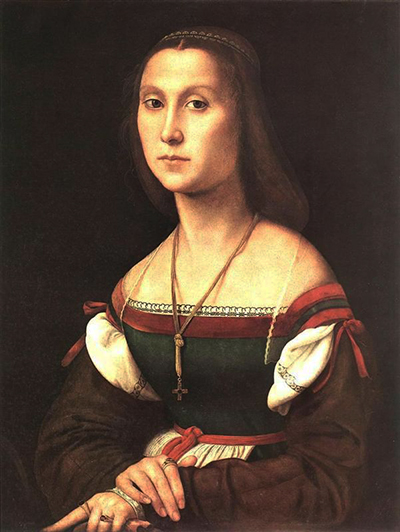The Portrait of a Woman by Raphael Sanzio was completed at the start of the 16th century. It depicts a pregnant woman sitting as she holds her belly.
The woman in the painting is thought to be a member of the Bufallini family of Citta di Castello. Before the 18th century, the artist behind the painting had been unknown. It was only later that Raphael was identified as the actual artist. Raphael completed this painting in Florence, Italy, and it is currently sitting in the same city.
Commonly referred to as La Donna Gravida, this masterpiece was created using the oil on wood painting technique. This method simply involves the use of a medium of drying oil as the binder. Oil on wood painting was originally used in the Far East, but the practice grew popular in Europe during the Middle Ages. The La Donna Gravida painting was created around this period. At the height of the Renaissance, this form of painting had become the principal painting technique in Europe as the artist learned of its advantages.
Oil on wood painting starts with the artist sketching the subject on the painting surface. For this part, they will use charcoal or thinned paint. As a general rule, upper layers have to use more oil than the lower layers as this will allow the painting to dry properly. Failure to follow this rule can make the painting crack over time. Old paintings like La Donna Gravida have been able to survive this long because of the use of proper painting techniques. The quality of paint and oil will also determine how long the painting lasts.
Raphael, Michelangelo, and Leonardo da Vinci form the trinity of the great artists of the Renaissance period. Many of Raphael’s works are stored in the Vatican, but La Donna Gravida is available at the Palazzo Pitti in Florence, Italy. Raphael lived for a part of his life in this part of Italy as he absorbed the Florentine painting styles and themes. Leonardo da Vinci had a great influence on Raphael during his stay in the city, and this was reflected in his works during his visit. The two artists stayed in Florence at around the same time, although Raphael was not really a permanent resident in the area.
His art still remained tranquil, although he made a few dynamic paintings. One of them was a picture of half-naked men fighting- people in this part of Italy were obsessed with such paintings at the time. Paintings of pregnant women were not common in other parts of Europe or even Italy, so his La Donna Gravida painting stood out. Raphael highly influenced the high Renaissance contemporary art, but after his death, the classic art of the period subsided. It was succeeded by Michaelangelo’s Mannerism art. The influence of Raphael’s art was experienced in varying degrees until the 19th century.




